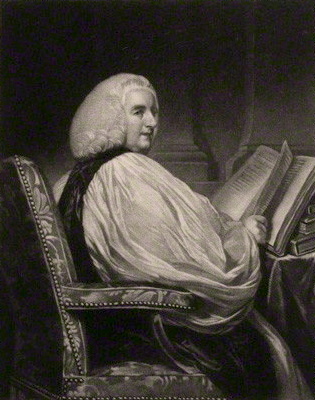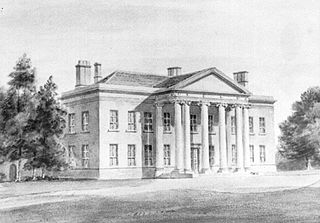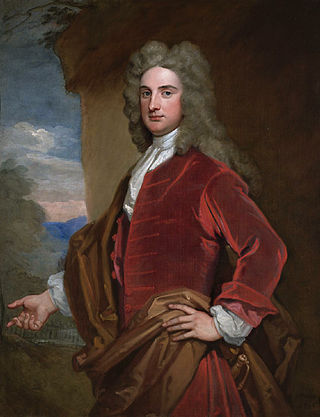
Marquess of Headfort is a title in the Peerage of Ireland. It was created in 1800 for Thomas Taylour, 2nd Earl of Bective.

Earl of Radnor, of the County of Radnor, is a title which has been created twice. It was first created in the Peerage of England in 1679 for John Robartes, 2nd Baron Robartes, a notable political figure of the reign of Charles II. The earldom was created for a second time in the Peerage of Great Britain in 1765 for William Bouverie, 2nd Viscount Folkestone.

Earl of Chichester is a title that has been created three times, twice in the Peerage of England and once in the Peerage of the United Kingdom. The current title was created in the Peerage of the United Kingdom in 1801 for Thomas Pelham, 2nd Baron Pelham of Stanmer.

Earl of Bradford, of Bradford in the County of Salop, is a title that has been created twice, once in the Peerage of England and once in the Peerage of the United Kingdom. It was first created in 1694 for Francis Newport, 2nd Baron Newport. However, all the Newport titles became extinct on the death of the fourth Earl in 1762. The earldom was revived in 1815 for Orlando Bridgeman, 2nd Baron Bradford. The Bridgeman family had previously succeeded to the Newport estates.

Baron Rokeby, of Armagh in the County of Armagh, was a title in the Peerage of Ireland. It was created in 1777 for The Most Rev. Dr Richard Robinson, Church of Ireland Lord Primate of All Ireland and Lord Archbishop of Armagh, with remainder to his brothers and his father's second cousin Matthew Robinson and the heirs male of their bodies. In 1785 he also succeeded his elder brother as 3rd Baronet according to a special remainder. Lord Rokeby never married and was succeeded in the barony and baronetcy according to the special remainders in the letters patent by his third cousin Matthew Robinson-Morris, the second Baron and fourth Baronet. He was the son of Matthew Robinson, son of Thomas Robinson, son of Sir Leonard Robinson, brother of William Robinson, great-grandfather of the first Robinson Baronet and the first Baron Rokeby. The second Baron was an academic, politician and eccentric. Born Matthew Robinson, he assumed by Royal licence the additional surname of Morris in 1746 on succeeding to the Mount Morris Estate in Monks Horton, Kent through his mother. He never married and was succeeded by his nephew Morris Robinson, the third Baron. He was the elder son of Morris Robinson.

Spye Park is a former country estate in Bromham parish in Wiltshire, England. It lies north of Chittoe, about 1.5 miles (2.4 km) north-west of Bromham village and 2.5 miles (4 km) east of Lacock. The historic house which stood there, near the Roman road from London to Bath, had been twice destroyed by fire, most recently in 1974. The new owner, as of 2005, was planning to rebuild a Palladian house.

There have been two baronetcies created for members of the Dashwood family, one in the Baronetage of England and one in the Baronetage of Great Britain. Both creations are extant as of 2008.
There have been four baronetcies created for people with the surname Hoare, one in the Baronetage of Ireland, one in the Baronetage of Great Britain and two in the Baronetage of the United Kingdom. The second holder of the third creation was raised to the peerage as Viscount Templewood in 1944.

Thomas Taylour, 1st Earl of Bective, KP, PC (Ire) was an Irish peer and politician.

Baron Selsey, of Selsey in the County of Sussex, was a title in the Peerage of Great Britain. It was created on 13 August 1794 for Sir James Peachey, 4th Baronet, Master of the Robes to King George III. He was succeeded by his son, the second Baron. He represented St Germans and Shoreham in Parliament. His eldest son, the third Baron, was a Captain in the Royal Navy. The titles became extinct on his death in 1838.

Baron Northwick, of Northwick Park in the County of Worcester, was a title in the Peerage of Great Britain. It was created in 1797 for Sir John Rushout, 5th Baronet, for many years Member of Parliament for Evesham. He was succeeded by his son, the second Baron, who was a noted collector of art. He, in turn, was succeeded by his nephew, the third Baron, the son of George Rushout-Bowles, younger son of the first Baron. He represented Evesham and Worcestershire East in Parliament. Lord Northwick had no surviving children and the titles became extinct on his death in 1887.
There have been four baronetcies created for persons with the surname Butler; two in the Baronetage of Ireland and two in the Baronetage of the United Kingdom. As of 2014 two of the creations are extant.

There have been two baronetcies created for members of the Codrington family, one in the Baronetage of Great Britain and one in the Baronetage of the United Kingdom. The family was for a long time connected with Dodington Park.
Stanley Abbey was a medieval abbey near Chippenham, Wiltshire, England, which flourished between 1151 and 1536.
There have been three baronetcies created for persons with the surname Clayton, two in the Baronetage of Great Britain and one in the Baronetage of the United Kingdom. One creation is extant as of 2021.

There have been three baronetcies created for persons with the surname Carew, two in the Baronetage of England prior to 1707, one in the Baronetage of Great Britain.
Sir Edward Bayntun, of Bromham, Wiltshire, was a gentleman at the court of Henry VIII of England. He was vice-chamberlain to Anne Boleyn, the King's second wife, and was the brother-in-law of Queen Catherine Howard, Henry VIII's fifth wife.
Sir Edward Bayntun-Rolt, 1st Baronet (1710–1800) was a British landowner and Whig politician who sat in the House of Commons for 43 years from 1737 to 1780. His election in 1741 was instrumental in the downfall of Sir Robert Walpole's premiership.
Sir Andrew Bayntun-Rolt, 2nd Baronet (1755–1816), of Spye Park, Bromham, Wiltshire, was a British politician who sat in the House of Commons from 1780 to 1786.

Edward Rolt of Sacombe Park, Hertfordshire, Harrowby Hall, Lincolnshire and Spye Park, near Chippenham, Wiltshire, was a British landowner and Tory politician who sat in the House of Commons from 1713 to 1722.












